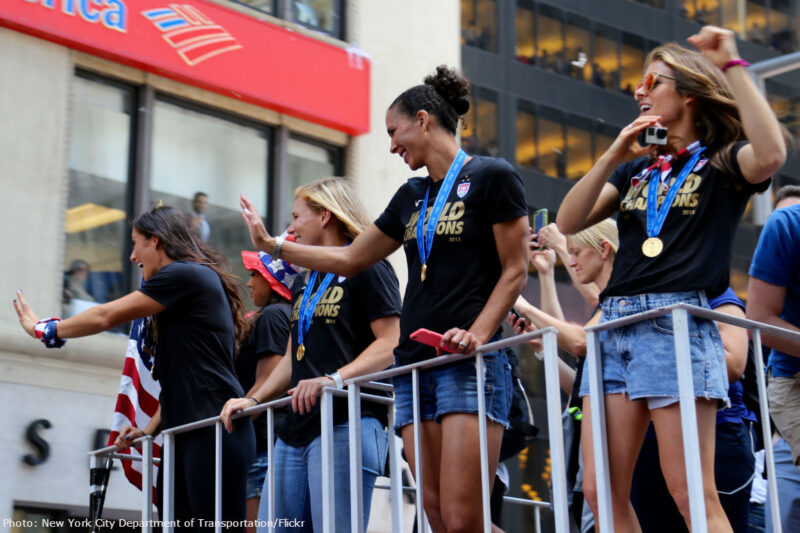After the Ticker Tape Parade, a Grim Reality for the U.S. Women’s Soccer Team


The U.S. Women’s National Soccer Team has won three World Cup championships. Four times, they’ve won Olympic gold. They’ve been ranked number one in the world for most of the past seven years. They’ve been feted at the White House, where President Obama celebrated them for showing that “playing like a girl means being the best.” And they’ve been a serious moneymaker for the U.S. Soccer Federation, setting records for television viewership and fueling a nearly $18 million profit for the USF in 2015.
They also, it turns out, are paid a fraction of what their male counterparts earn.
In a charge filed this week with the Equal Employment Opportunity Commission, five of the most prominent members of the women’s team — including co-captains Becky Sauerbrunn and Carli Lloyd (the MVP of the 2015 World Cup) — allege that U.S. Soccer’s compensation practices violate both Title VII, the federal law against sex discrimination in employment, and the Equal Pay Act, which specifically addresses sex-based wage disparities.
The charge alleges inequality in all aspects of the USF’s compensation structure. For instance, with respect to World Cup play, female players earn just $30,000 for being asked to join the roster, while men make more than twice that at $68,750. And those disparities increase as the teams progress through the tournament, such that the U.S. Men’s National Soccer Team lost in the Round of 16 in the 2015 World Cup but still earned a total of $9 million, while the women’s team won the tournament and received just $2 million.
Similarly, for instance, both female and male players are committed to 20“friendly” matches per year, earning different amounts based on the games’ outcomes. But the structure assures that if both teams won every game, the women would make 38 percent less than the men.
It now will be up to the EEOC to investigate and to determine whether USF can justify the pay differentials as stemming from legitimate factors other than sex. In the meantime, the women’s team prepares for the August Olympics in Rio de Janeiro, though some news accounts have hinted that a boycott might not be off the table.
The players' filing is just the latest and splashiest evidence of disparities between male and female athletes. And even in the few realms where women have finally achieved parity, there is backlash. Last month, the male CEO of one of the year’s preeminent tennis tournaments denigrated women players, who now win the same prize money as men, as “rid[ing] on the coattails of the men” and claimed that male players “carr[y] this sport.” (Runner-up Serena Williams was among those quick to denounce this perception, noting that the 2015 U.S. Open women’s final sold out before the men’s.) The top-ranked Novak Djokovic chimed in, voicing his belief that women players shouldn’t earn equal prize money because it’s the men’s game that “attracts more attention, spectators” and “sells more tickets and stuff like that.”
Because these controversies have embroiled some our most famous athletic heroines, they’ve temporarily won public attention. But the gender wage gap is a daily reality for millions of women who will never be on the front page of the sports section.
The numbers are sobering. Women’s wages remain stuck at an average of 79 percent of men’s. On April 12, advocates will mark Equal Pay Day, the day on which women finally reach the 100 cents on the dollar that men earned, on average, by the end of last year. Black women, though, will have to wait until July 21 to earn that full dollar (they make just 63 percent of what white men earn) and Latinas won’t get to “celebrate” their Equal Pay Day until October 15, given that they earn just 54 percent of white men.
There’s plenty of debate about the reasons for these gaps, but some things are for sure. Fifty-three years after the enactment of the Equal Pay Act and 52 years after Congress outlawed all sex discrimination on the job, women still are disproportionately segregated in the lowest-wage fields — health care, education, social services, and service industries. And that segregation alone accounts for roughly half of the wage gap, social scientists say. Two strands of recent research are especially dispiriting in their confirmation of how little “women’s work” is valued. One series of reports found that men who work in female-dominated fields earn more than their female coworkers and are promoted into supervisory roles more often. On the flip side, researchers have learned that when women begin entering historically male-dominated jobs, the result is an overall decrease in wages.
So what’s the way forward? Enacting stronger equal pay legislation, like the Paycheck Fairness Act, can only help, as can litigation to enforce those laws and correct known inequities. Demonstrated zero tolerance from top managers, like the brave CEOs willing to look at the pay statistics right under her or his nose, also will go a long way. President Obama’s recent initiatives to require federal contractors and large private employers to regularly track their pay practices — by race and ethnicity as well as by gender — reflect yet another strategy for exposing systemic disparities.
But rooting out the age-old stereotypes that fundamentally overvalue the work done by men versus by women — the ones that divide cleaning staffs into “janitors” and “housekeepers,” and pay one group more than the other — will take years. That’s why it’s a welcome jolt when some of the world’s most celebrated female athletes step forward and tell us that for all of their success and fame, pay discrimination happened to them, too.




